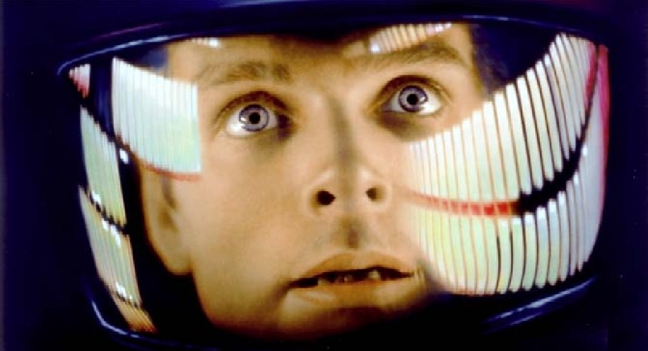
SINCE the Singularity Archetype is a primordial image and not an abstraction, I am going to conclude the book with one of the most powerful visions of it ever created. Once in a while a visionary genius will meld form and content to provide a portal for us to see a beautifully realized vision of the Singularity Archetype. The greatest example in the medium of animation I know of is Akira, in film, it’s 2001. Of course, as with all films, 2001 is a collaboration. What makes the creative synergy behind this film seem divine is that it included two powerful visionary geniuses, Arthur C. Clarke and Stanley Kubrick. The melding of their two minds elevates the viewer to a point where it seems as though we are witnessing the Singularity Archetype from the observation deck of a spaceship. There is a feeling of high optical quality in our view — the synthetic sapphire windows of the observation deck have been enhanced with high-performance anti-reflective coatings.
In the film version of 2001, form and content are combined to create a cosmic, impersonal view of the Singularity Archetype. For example, Kubrick chose relatively unknown actors to play characters who are all somewhat emotionally disassociated, and this helps us to have an impersonal, cosmic view of the archetype. The emotional disassociation also echoes the theme of psychopathy and dark evolutionary trends toward a loss of feeling. Every level of the movie seems close to perfection, including a few musical interludes. Jay Weidner discusses the significance of the overture in his intriguing essay on 2001, “Alchemical Kubrick: 2001, The Great Work on Film.”72 I got to discuss 2001 with Jay shortly after he’d published his essay. Here’s what Jay has to say about the overture:
“The soundtrack is the ‘World Riddle’ theme from Strauss’, ‘Thus Spoke Zarathustra’. Right away, from the beginning, Kubrick is showing the viewer the relationship between the writings of the philosopher Frederick Nietzche and his film, between transformation and extinction. The Zarathustra essays by Nietzche are his most revealing and magical. Zarathustra is the great prophet of the Zoroastrians, who are the early holders of the great alchemical tradition. Kubrick is saying that this film echoes the words of Zarathustra who taught of the great transformation from the mundane to the angelic. This is one of the most dramatic openings in the history of the cinema. It is important to note that these magical, celestial alignments are dotted throughout the film and that they hold a key to the main theme.”
It is impossible to obtain a complete view of any archetype since this would require the inclusion of the myriad ways that every individual psyche has ever experienced it. The view from 2001, however, is as fully realized, high-resolution, high-contrast a view as we’re likely to get from an individual version, the best that two visionaries, at the height of their powers, could produce. 2001 also deserves extended individual consideration because it manages to merge the personal and collective views of the event horizon, combining the event horizon of death with that of species metamorphosis.
It would take too many pages to try to recapitulate the plot of this novel/film (the two forms were constructed simultaneously). I am going to presume from here on out that the reader has at least experienced the movie. If you haven’t, stop reading and watch it in HD in a context of sacred concentration. If it’s been a while since you’ve seen the film, watch it again. The book is also a masterpiece, and ideally, the two forms should be experienced together, each enhancing each. From here on out, I’m going to merge both of them as I discuss their mutual storyline.
We first encounter the event horizon through a singular object that, like an archetype, is also a subject. The black monolith is as singular an object as a black hole. It has been designed by its makers to be many things, and it serves various functions: intelligent sentinel, a monument to great cycles of time and development, an evolutionary catalyst, Pandora’s Box, and Star Gate. To one character, the monolith is ominously reminiscent of a giant tombstone. It is a tombstone/Star Gate, an opening-
72 Available at http://www.jayweidner.com/kubrick2.htm.
-that exists at the twin event horizons of death/eschaton. It is not a dead end but a portal that you travel through to metamorphose.
Jay Weidner points out some alchemical aspects of the monolith:
“’Monolith’ comes from the Greek ‘Mon’ and ‘Lith’. ‘Mon’ means ‘one’ and ‘lith’ means ‘stone’. So the ‘monolith’ is a direct reference to ‘one stone’. This film then, is about the one stone, or the single stone. And in this case, Kubrick has made sure that the stone is black.
“In alchemy all things that exist come from the black stone, or the ‘prima materia’. The black stone is the stone of transformation, and even more important to this argument the stone of projection. This is the Philosopher’s Stone. This is the object that can change, or transmute mankind, according to alchemical lore. It is rare and, when it makes an appearance, it transforms the seeker. There is little doubt that the black monolith in ‘2001’ is the Philosopher’s Stone.”

The monolith makes its first appearance in a community of missing-link primates. When the primates are given a metamorphic shock from the monolith, one of the very first changes is their discovery of weapons. After these enhanced primates use their newly acquired weapons technology to defeat a competing clan of primates, one of them takes the bone he has used as a truncheon and tosses it triumphantly up into the air. Our eye follows the bone’s ascending arc until in a twenty-fourth of a second, the film splices out 50,000 years of development such that we see its arc continuing as a bone-white spacecraft.
The spacecraft that the bone turns into was intended by Clarke/Kubrick to be a nuclear doomsday satellite orbiting the Earth. Since Kubrick’s last work was Dr. Strangelove or: How I Learned to Stop Worrying and Love the Bomb (1964), it was deemed inappropriate to have yet another explicit nuclear doomsday scenario, so the original intention got muted. The arc of bone/spacecraft represents the triumph of technological development but also the apocalyptic expression of primate territorial aggression. The world of futuristic high technology is still a primate world, a world that is hurtling toward another evolutionary event horizon. Even the name of the protagonist, “Bowman,” suggests that we are still in the primitive weapon mindset.
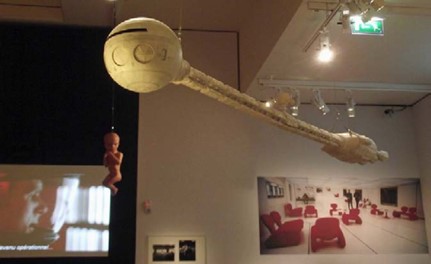
2001 artifacts—the Starchild and Discovery ONE
The outward-bound spacecraft Discovery One, resembles a lone sperm cell traveling through the sterile vastness of space. Its journey involves a profound series of ego deaths and actual deaths. When the monolith is first excavated, we see a technocratic politician and a few others lined up in front of it to have their picture taken. Although the characters recognize a historic moment, they don’t realize that it is actually an end-of-history moment. Psychologically, they are still primates in social hierarchy mode, their motivation is not very different from a group of adolescents getting their team photo taken after besting a rival high school. But then the piercing signal emitted by the singularity brings them to their knees.
For human beings to travel anywhere in space, they must go through an ego death of sorts because their physical form is fragile and not designed for space travel. They must eat baby food and undergo toilet training. To go even as pitifully short a distance as the middle of their own solar system, they have to be brought to the edge of death and put into suspended animation in a container that looks like a sarcophagus.
And then something goes wrong in the dawning relationship between the human form and artificial intelligence. These two life forms come to recognize each other as caught in a zero-sum game of deadly competition. HAL breaks the radio link with Earth, and that is another death. Now the spacecraft is an isolated crucible traveling through space.
See: AI, the Singularity Archetype, and the High Possibility or an Impending Viral Apocalypse
The denouement of a huge evolutionary cycle plays itself out in this lonely crucible. In the course of the struggle, all of Bowman’s companions die, and then HAL must die for Bowman to continue the journey. Bowman travels toward what looks from space like a giant eye on the Saturnian moon, Japetus. In a small pod, Bowman attempts to land on the pupil of this eye, which closer examination reveals to be the giant black monolith. When he does land, however, he discovers that this is not an object but a singularity. There is no roof but something more like an M.C. Escher, inside-out optical illusion. He finds that he is hurtling through what is both an interdimensional corridor and an evolutionary event horizon. It is both the threshold of death and a birth canal. The canal he passes through is also the tunnel so often described in the NDE, where the experiencer will often say they feel like they are traveling at the speed of light. For example, a near-death experiencer reports:
“The blackness began to erupt into a myriad of stars and I felt as if I were at the center of the Universe with a complete panoramic view in all directions. The next instant I began to feel a forward surge of movement. The stars seemed to fly past me so rapidly that they formed a tunnel around me” (LL 275).
And now from 2001:
“The star field was expanding, as if it was rushing toward him at an inconceivable speed. The expansion was nonlinear, the stars at the center hardly seemed to move, while those toward the edge accelerated more and more swiftly, until they became streaks of light just before they vanished from view” (259-60).
2001 was written several years before Raymond Moody coined the term near-death experience in his first book, Life After Life. The life review that is so well-known now was barely known at all when 2001 was created. Here’s one man’s description of his life review:
“It’s like a picture runs in front of your eyes, like from the time you can remember up to the time, you know, what was happening [that is, the present moment]… It seems like pictures of your life just flow in front of your eyes, the things you used to do when you were small and stuff: stupid things… It was like a picture, it was like a movie camera running across your eyes. In a matter of a second or two. Just boom, boom [snaps his fingers]. It was clear as day, clear as day. It was very fast and you could see everything” (LL 146).
And here’s a similar description from a woman:
“It was amazing. I could see in the back of my head an array, just an innumerable array of thoughts, memories, things I had dreamt, just in general thoughts and recollections of the past, just raced in front of me, in less than thirty seconds. All these things about my mother and grandmother and my brothers and these dreams I’ve had. I felt like this frame, millions of frames, just flashed through. It was thoughts and images of people. And a lot of thoughts just raced [snaps her fingers several times] in split seconds. I had my eyes closed under water, but I could still see those images.” [ LL, 145]
Finally, here’s the description of what happens to Bowman as he crosses the event horizon:
“The springs of memory were being trapped; in controlled recollections, he was reliving the past. […] And not only vision, but all the sense impressions, and all the emotions he had felt at the time, were racing past, more and more swiftly. His life was unreeling like a tape recorder playing back at ever-increasing speed. […] And even as he relived these events, he knew that all was indeed well. He was retrogressing down the corridors of time, being drained of knowledge and experience as he swept back toward his childhood. But nothing was being lost; all that he had ever been, at every moment of his life, was being transferred to safer keeping. Even as one David Bowman ceased to exist, another became immortal” (2001 290).
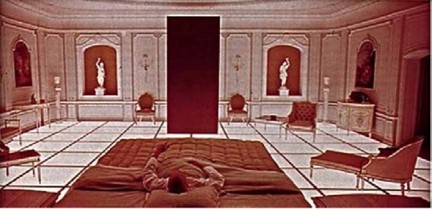
As Bowman travels through the interdimensional corridor, there is a subject/object shift as our point of view merges with that of Bowman, and together we witness cosmic vistas that seem both biological and astronomical. Like an NDE, we see what seems like new colors and uncanny, penetrating light. As in the NDE, there are multiple autoscopic experiences as Bowman sees his body from a disembodied perspective. He goes through the human life cycle in a series of subject-object reversals. He sees himself as an older man eating at a table, and then he becomes the older man, then the older man sees himself as profoundly old and on his deathbed. Then he is on his deathbed, and the monolith appears in front of him as both a tombstone and an evolutionary portal. As a dying man, he reaches toward the monolith in the identical manner of Adam reaching toward God in Michelangelo’s God Creating Adam.
Out of the birth canal, he is reborn as the Star Child. The Star Child has large, luminous eyes and exists within a luminous sphere similar to the spherical vision of some near-death experiencers, who discover themselves to be luminous spheres of awareness that can see and travel in any direction at will.
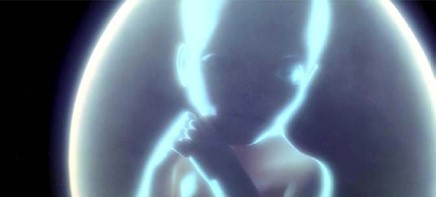
The birth of the Star Child is the re-emergence of the glorified body, a body of awareness freed from the tyranny of matter. This evolutionary step comes thanks to entities, the creators of the monoliths, the singularity-makers, who are the products of an evolutionary process that allowed them to emerge into glorified bodies:
“And now, out among the stars, evolution was driving toward new goals. The first explorers of Earth had long since come to the limits of flesh and blood; as soon as their machines were better than their bodies, it was time to move. First their brains, and then their thoughts alone, they transferred into shining new homes of metal and of plastic.
“In these, they roamed among the stars. They no longer built spaceships. They were spaceships.
“But the age of the Machine-entities swiftly passed. In their ceaseless experimenting, they had learned to store knowledge in the structure of space itself, and to preserve their thoughts for eternity in frozen lattices of light. They could become creatures of radiation, free at last from the tyranny of matter.”
And here is Bowman’s experience of emerging into a glorified body:
“He still needed, for a little while, this shell of matter as the focus of his powers. His indestructible body was his mind’s present image of itself; and for all his powers, he knew that it was still a baby. So he would remain until he had decided on a new form, or had passed beyond the necessities of matter” (2001 293).
Instead of concluding the book with more analysis, it seems fitting to end with the visionary experience of Bowman, as he crosses the event horizon:
“He knew that this formless chaos, visible only by the glow that limned its edges from fire-mists far beyond, was the still unused stuff of creation, the raw material of evolutions yet to be. Here, Time had not begun; not until the suns that now burned were long since dead would light and reshape this void.
“Unwittingly, he had crossed it once; now he must cross it again—this time, of his own volition. The thought filled him with a sudden, freezing terror, so that for a moment he was wholly disoriented, and his new vision of the universe trembled and threatened to shatter into a thousand fragments.
“It was not fear of the galactic gulfs that chilled his soul, but a more profound disquiet, stemming from the unborn future. For he had left behind the time scales of his human origin; now, as he contemplated that band of starless night, he knew his first intimations of the Eternity that yawned before him.
“Then he remembered that he would never be alone, and his panic slowly ebbed. The crystal-clear perception of the universe was restored to him — not, he knew, wholly by his own efforts. When he needed guidance in his faltering steps, it would be there.
“Confident once more, like a high diver who had regained his nerve, he launched himself across the light-years. The galaxy burst forth from the mental frame in which he had enclosed it; stars and nebulae poured past him in an illusion of infinite speed. Phantom suns exploded and fell behind as he slipped like a shadow through the cores; the cold, dark waste of cosmic dust which he once feared seemed no more than the beat of a raven’s wing across the face of the Sun.
“The stars were thinning out; the glare of the Milky Way was dimming into a pale ghost of the glory he had known — and, when he was ready, would know again.
“He was back, precisely where he wished to be, in the space that men called real” (2001 295-6).
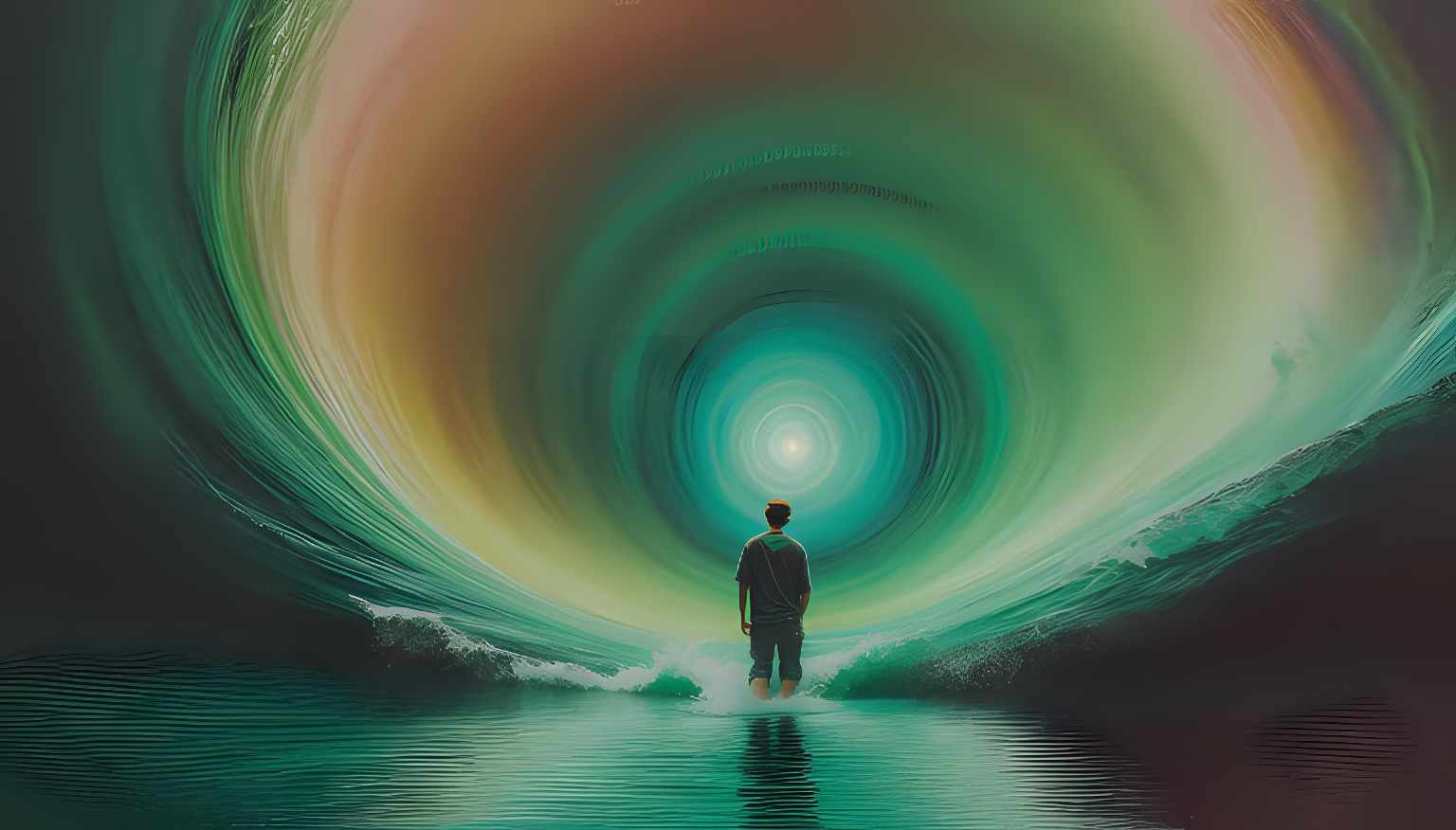
This website is the product of tens of thousands of hours of work. Making all this content available free and without ads means this enterprise runs at a lifetime six-figure loss. That hurts my feelings as well as my finances! Please help out!
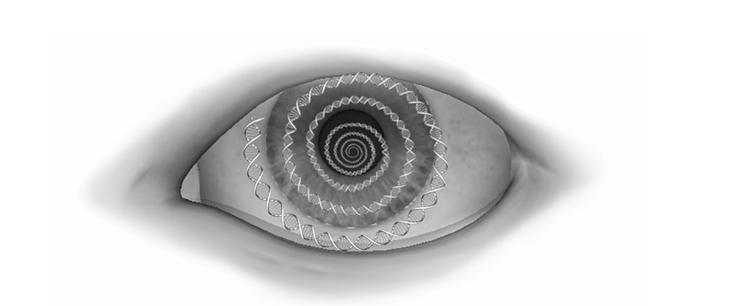
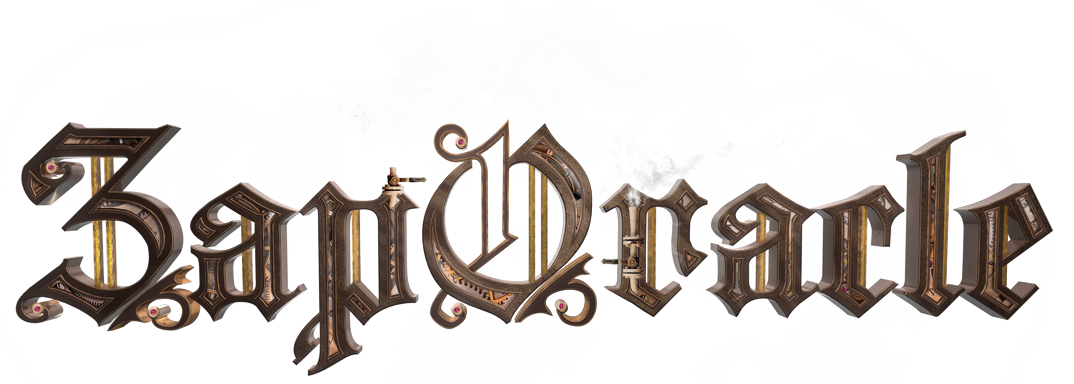 ZapOracle.com home to the free 720-card Zap Oracle
ZapOracle.com home to the free 720-card Zap Oracle



